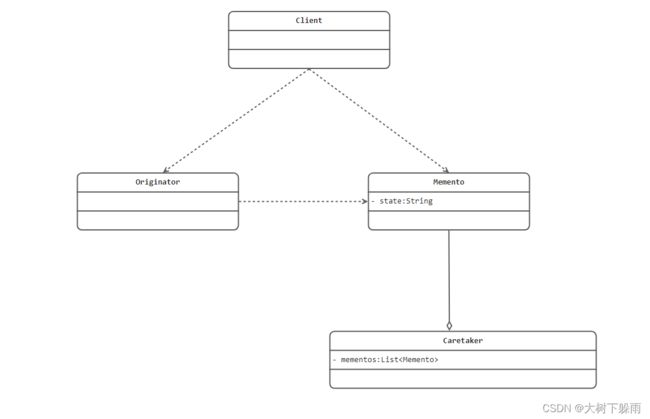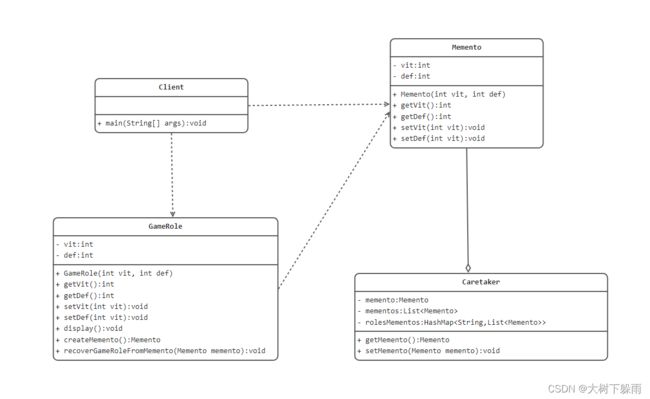备忘录设计模式
备忘录设计模式
一、备忘录设计模式
1、介绍
备忘录模式:在不破坏封装性的前提下,捕获一个对象的内部状态,并在该对象之外保存这个状态。这样以后就可将对象恢复到原先保存状态
备忘录对象主要用来记录一个对象的某种状态或者某些数据,当要回退时,可以从备忘录对象离获取原来的数据进行恢复操作
备忘录模式属于行为型模式
2、UML
Orginator:对象(需要保存状态的对象)
Memento:备忘录对象,负责保存Orginator内部状态的
Caretaker:守护者对象,负责保存多个备忘录对象,使用集合管理,提高效率
3、备忘录模式的注意事项和细节
- 给用户提供了一种可以恢复状态的机制,可以使用户能够比较方便地回到某个历史的状态
- 实现了信息的封装,使得用户不必关心状态的保存细节
- 如果类的成员变量过多,势必会占用比较大的资源,而且每一次保存都会消耗一定的内存
- 适用场景:后悔药、游戏存档、windows中的撤回(ctri+z)、浏览器中的后退、数据库的事务管理
- 为了节约内存,备忘录模式可以和原型模式配合使用
二、案例1
1、介绍
使用备忘录模式,备忘对象Originator的属性state,可通过备忘录对象恢复
2、UML
3、代码
/**
* @description: 源
* @author: dashu
* @create: 14:09
*/
public class Originator {
/**
* 状态
*/
private String state;
/**
* 获取状态
* @return
*/
public String getState() {
return state;
}
/**
* 状态赋值
* @param state 状态
*/
public void setState(String state) {
this.state = state;
}
/**
* 保存状态到备忘录
* @return
*/
public Memento saveStateMemento(){
return new Memento(state);
}
/**
* 通过备忘录恢复状态
* @param memento
*/
public void getSateFromMemento(Memento memento){
state = memento.getState();
}
}
/**
* @description: 备忘录
* @author: dashu
* @create: 14:07
*/
public class Memento {
/**
* 状态
*/
private String state;
public Memento(String state){
this.state = state;
}
public String getState() {
return state;
}
}
/**
* @description: 备忘录管理员
* @author: dashu
* @create: 14:13
*/
public class Caretaker {
/**
* 备忘录集合
*/
private List<Memento> mementos = new ArrayList<>();
/**
* 备忘录添加
* @param memento
*/
public void add(Memento memento){
mementos.add(memento);
}
/**
* 根据索引索取备忘录
* @param index 索引值
* @return
*/
public Memento get(int index){
return mementos.get(index);
}
}
/**
* @description: 客户端
* @author: dashu
* @create: 14:06
*/
public class Client {
public static void main(String[] args) {
Originator originator = new Originator();
Caretaker caretaker = new Caretaker();
originator.setState("状态#1 攻击力 100");
//保存当前状态
caretaker.add(originator.saveStateMemento());
originator.setState("状态#2 攻击力 80");
//保存当前状态
caretaker.add(originator.saveStateMemento());
originator.setState("状态#3 攻击力 10");
//保存当前状态
caretaker.add(originator.saveStateMemento());
System.out.println("恢复状态2:");
originator.getSateFromMemento(caretaker.get(1));
System.out.println("当前状态:" + originator.getState());
}
}
三、案例2
1、介绍
通过备忘录模式备忘游戏角色的属性,并通过备忘录对象恢复
2、UML
3、代码
/**
* @description: 游戏角色
* @author: dashu
* @create: 14:19
*/
public class GameRole {
/**
* 攻击力
*/
private int vit;
/**
* 防御力
*/
private int def;
public GameRole(int vit, int def) {
this.vit = vit;
this.def = def;
}
public void display() {
System.out.println("游戏角色当前的攻击力:" + this.vit + ",防御力:" + this.def);
}
public int getVit() {
return vit;
}
public void setVit(int vit) {
this.vit = vit;
}
public int getDef() {
return def;
}
public void setDef(int def) {
this.def = def;
}
public Memento createMemento() {
return new Memento(vit, def);
}
public void recoverGameRoleFromMemento(Memento memento) {
this.vit = memento.getVit();
this.def = memento.getDef();
}
}
/**
* @description: 备忘录
* @author: dashu
* @create: 14:21
*/
public class Memento {
/**
* 攻击力
*/
private int vit;
/**
* 防御力
*/
private int def;
public Memento(int vit, int def) {
this.vit = vit;
this.def = def;
}
public int getVit() {
return vit;
}
public void setVit(int vit) {
this.vit = vit;
}
public int getDef() {
return def;
}
public void setDef(int def) {
this.def = def;
}
}
import java.util.HashMap;
import java.util.List;
/**
* @description: 备忘录管理员
* @author: dashu
* @create: 14:16
*/
public class Caretaker {
private Memento memento;
private List<Memento> mementos;
private HashMap<String,List<Memento>> rolesMementos;
public Memento getMemento() {
return memento;
}
public void setMemento(Memento memento) {
this.memento = memento;
}
}
/**
* @description: 客户端
* @author: dashu
* @create: 14:26
*/
public class Client {
public static void main(String[] args) {
GameRole gameRole = new GameRole(100,100);
System.out.println("和BOOS大战前状态:");
gameRole.display();
System.out.println("保存状态....");
Caretaker caretaker = new Caretaker();
caretaker.setMemento(gameRole.createMemento());
System.out.println("和BOOS大战后状态:");
gameRole.setVit(30);
gameRole.setDef(30);
gameRole.display();
System.out.println("使用备忘录恢复状态....");
gameRole.recoverGameRoleFromMemento(caretaker.getMemento());
gameRole.display();
}
}


